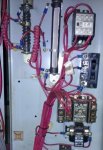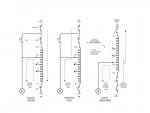big john
Senior Member
- Location
- Portland, ME
Have a 4160V RVAT motor starter where the autotransformer appears to have fried because it never switched out of start sequence.
This thing is good and old: It still use a Sylvania pneumatic relay to actuate the timing functions.
What surprises me is that where I would expect to see multiple control relays for the multiple power contactors, this thing is running with a single control relay and a single timing relay. Attached is a picture:
I want to double-check my understanding before tearing into this:

1) All RVAT starters equipped with "Main", "Start", and "Run" contactors are by default going to be closed transition? Correct?
2) If you're doing all this switching with a single timing relay, wouldn't that mean it had to be a make-before-break set of contacts?
3) Why would those two power resistors be necessary?
Thanks for any insight.
This thing is good and old: It still use a Sylvania pneumatic relay to actuate the timing functions.
What surprises me is that where I would expect to see multiple control relays for the multiple power contactors, this thing is running with a single control relay and a single timing relay. Attached is a picture:
I want to double-check my understanding before tearing into this:

1) All RVAT starters equipped with "Main", "Start", and "Run" contactors are by default going to be closed transition? Correct?
2) If you're doing all this switching with a single timing relay, wouldn't that mean it had to be a make-before-break set of contacts?
3) Why would those two power resistors be necessary?
Thanks for any insight.




